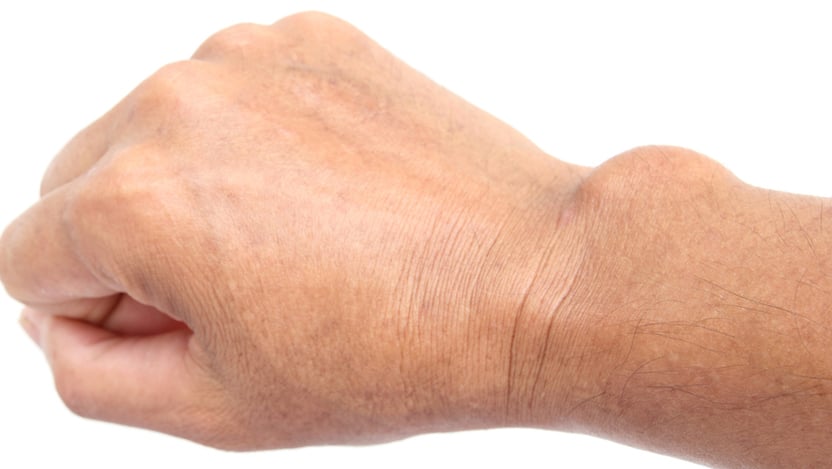Your wrist is a marvel of engineering, composed of eight small bones linked by ligaments, tendons, and muscles. This complex joint is designed to provide a wide range of motion—from bending and rotating to gripping and lifting. However, its complexity also makes it vulnerable to various types of injuries and overuse issues. For instance, even a minor sprain can affect the delicate balance of the wrist’s components, leading to prolonged discomfort. Learning a little about how your wrist works can help demystify some of the causes behind the pain you might be experiencing.

Common Causes of Wrist Pain
Repetitive Strain and Overuse
In today’s digital era, many of us spend hours typing, scrolling on our phones, or using other electronic devices. This constant repetitive motion can lead to overuse injuries. When you repeat the same movements over and over, tiny strains build up in the tendons and muscles, eventually causing pain. According to Healthline, these repetitive tasks can lead to conditions like tendonitis and carpal tunnel syndrome. Over time, what starts as a minor annoyance can evolve into chronic pain if the underlying strain isn’t addressed.
Carpal Tunnel Syndrome
Carpal tunnel syndrome occurs when the median nerve, which runs from your forearm into your hand, becomes compressed as it passes through a narrow passage in your wrist. This pressure can result in symptoms such as tingling, numbness, and a burning sensation in your thumb, index, and middle fingers. The Mayo Clinic explains that factors like repetitive hand movements and wrist positioning can contribute to this nerve compression. Although it might sound technical, think of it like a garden hose: if you squeeze it too tightly, the water flow (or in this case, the nerve signals) is disrupted.
Tendonitis and De Quervain’s Tenosynovitis
Tendonitis is the inflammation or irritation of a tendon—the fibrous tissue connecting muscles to bones. One particularly common type of tendonitis affecting the wrist is de Quervain’s tenosynovitis. This condition often arises from repetitive motions, especially those involving the thumb. New mothers, for instance, may experience what’s colloquially known as “mommy wrist” due to the strain of lifting and holding a baby in an awkward position. SSM Health offers practical advice on modifying how you lift and support your baby, highlighting that small adjustments in posture can significantly reduce the strain on your wrist.
Arthritis
Arthritis isn’t just a condition that affects your knees or hips—it can also strike your wrists. Whether it’s osteoarthritis, where the cartilage cushioning your joints wears down over time, or rheumatoid arthritis, an autoimmune disorder that causes joint inflammation, both types can lead to persistent wrist pain. Penn Medicine outlines how these conditions can gradually reduce the wrist’s range of motion and strength, often requiring a combination of medication, lifestyle modifications, and sometimes even surgery to manage.
Ganglion Cysts
Sometimes, a visible lump on your wrist can be more than just a cosmetic issue—it might be a ganglion cyst. These are benign, fluid-filled sacs that develop near joints or tendons. Although most ganglion cysts are harmless, they can press on nerves or interfere with joint movement, causing discomfort. UChicago Medicine notes that while the exact cause isn’t always clear, minor injuries or joint stress are often to blame. Treatment may involve simply monitoring the cyst, draining it, or, in some cases, surgical removal if it interferes with your daily activities.
Injuries, Sprains, and Fractures
Accidents happen, and when they do, your wrist is one of the most vulnerable areas. A fall, a direct blow, or even an awkward twist can lead to sprains, fractures, or dislocations. These injuries can vary from minor strains that improve with rest and ice to severe fractures that require medical intervention. Guidance from HSE Ireland emphasizes the importance of early treatment—rest, ice, compression, and elevation (RICE) are critical steps in managing these acute injuries.
Ergonomic and Lifestyle Factors
Sometimes, wrist pain is less about a specific injury and more about how we use our bodies every day. Poor ergonomics at work—like an improperly positioned keyboard or mouse—can force your wrist into unnatural angles, increasing the risk of strain and injury. Even recreational activities, such as cycling, can contribute. For example, HSS highlights how an improper bike fit can lead to excess pressure on the wrists, causing pain over time.
Recognizing the Symptoms
Wrist pain can manifest in various ways, making it important to pay attention to your body’s signals. Common symptoms include:
- Persistent pain or aching: Often felt deep within the joint or along the tendons.
- Swelling and stiffness: Your wrist might become noticeably swollen, especially after extended use.
- Numbness or tingling: Particularly in cases of nerve compression, such as with carpal tunnel syndrome.
- Reduced range of motion: Difficulty in bending, twisting, or gripping objects.
- Weakness: You may notice a decrease in grip strength, making everyday tasks more challenging.
If you experience these symptoms, it might be time to re-examine your daily habits or consult a healthcare professional for a proper diagnosis.
Diagnosing Wrist Pain: What to Expect
When you visit your doctor about persistent wrist pain, the evaluation typically starts with a detailed discussion of your symptoms and medical history. A physical examination follows, where the doctor will check for tenderness, swelling, and any deformities in your wrist. To get a clearer picture, imaging tests such as X-rays, MRIs, or ultrasounds might be ordered. These tests help visualize the bones, tendons, and soft tissues, making it easier to pinpoint the source of pain. The Mayo Clinic explains that such diagnostic measures are essential in guiding the most effective treatment plan.
Self-Care Strategies and Home Remedies
While professional medical advice is vital for severe or persistent pain, many cases of wrist discomfort can be managed at home. Here are several practical strategies to consider:
Rest and Activity Modification
One of the simplest ways to alleviate wrist pain is to give it a break. If your daily routine involves repetitive wrist movements, consider taking regular breaks and reducing the intensity of activities that strain your wrist. Whether it’s typing, texting, or lifting heavy objects, modifying your activities can provide much-needed relief. Incorporating short rest periods into your workday can prevent minor strains from developing into chronic issues.
Ice Versus Heat Therapy
Knowing when to use ice and when to apply heat is key to effective pain management. In the initial stages of an injury—such as a sprain or strain—ice is your best friend. Cold therapy helps reduce inflammation and numb the pain by constricting blood vessels. For more detailed guidance, check out the Cleveland Clinic infographic on ice versus heat. Conversely, if you’re dealing with chronic pain or stiffness due to conditions like arthritis, heat can help relax and loosen tight muscles, improving blood flow to the affected area. Alternating between the two, based on the timing and nature of your pain, can often yield the best results.
Over-the-Counter Medications and Topical Solutions
Non-steroidal anti-inflammatory drugs (NSAIDs) like ibuprofen can help reduce pain and inflammation. Additionally, topical gels that contain NSAIDs are a convenient option for targeted relief. For example, Voltarol offers a pain relief gel that works by delivering diclofenac directly to the painful area, providing long-lasting relief without the need for oral medications.
Splinting and Bracing
Immobilizing the wrist with a splint or brace can be especially helpful if you’re recovering from an injury. By limiting movement, these supports allow the inflamed tissues to rest and heal. They are also useful for preventing further strain during everyday activities, giving your wrist the chance it needs to recover fully.
Gentle Exercises and Stretches
Once your pain begins to subside, gentle exercises can help restore strength and flexibility. Simple stretches, like those described in the HEY NHS leaflet, are designed to gradually improve your wrist’s range of motion. Start slowly with exercises that involve extending and bending your wrist, and gradually incorporate rotations and gentle grip-strengthening movements. These exercises not only alleviate stiffness but also help in rebuilding muscle support around the joint.
Ergonomic Adjustments
Adopting better ergonomic practices in your daily life is a proactive way to manage and prevent wrist pain. Adjust your workstation so that your keyboard, mouse, and monitor are all at comfortable, natural heights and distances. When cycling, consider getting a professional bike fit to reduce undue pressure on your wrists, as recommended by HSS. Small changes like using a wrist rest while typing can make a big difference over time.
When to Seek Professional Help?
While many cases of wrist pain can be managed with self-care, certain symptoms warrant professional evaluation. If you experience any of the following, it’s important to consult a healthcare provider:
- Persistent pain: If the pain doesn’t improve after a few days of self-care.
- Numbness or tingling: These can indicate nerve involvement, such as in carpal tunnel syndrome.
- Deformity or significant swelling: These may suggest a fracture or severe sprain.
- Weakness or reduced grip strength: This can interfere with everyday tasks and might signal an underlying issue that needs medical attention.
The NHS advises that if these symptoms persist, it’s important to get a thorough evaluation to rule out any serious conditions.
Diagnosing Wrist Pain: A Closer Look
A proper diagnosis can mean the difference between a quick recovery and long-term issues. During a consultation, your doctor will likely inquire about your daily activities, any recent injuries, and the specific nature of your pain. Physical examinations are usually complemented by imaging tests like X-rays, MRIs, or ultrasounds, which help pinpoint the exact location and cause of the discomfort. In cases where nerve damage is suspected, tests like nerve conduction studies may be performed. The detailed diagnostic process outlined by Mayo Clinic underscores how critical it is to get an accurate diagnosis before starting any treatment.
Preventive Measures and Lifestyle Adjustments
Preventing wrist pain is often about making small, sustainable changes to your everyday habits. Here are a few strategies to keep your wrists healthy:
Ergonomic Workstation Setup
Invest in an ergonomic workstation if you spend long hours at a computer. Ensure that your desk, chair, keyboard, and mouse are set up to maintain a neutral wrist position. This means keeping your wrists straight and avoiding excessive bending or extension. Regular breaks are essential—set a timer to remind yourself to stretch and rest your wrists periodically.
Exercise and Strength Training
Strengthening the muscles around your wrist can help support the joint and prevent injuries. Simple exercises, such as wrist curls and extensions using light weights, can build resilience over time. Additionally, incorporating overall body exercises like yoga or Pilates can improve your posture and reduce the risk of repetitive strain injuries.
Proper Technique in Daily Activities
Whether you’re typing on a keyboard, playing sports, or cycling, using proper technique can prevent unnecessary strain. For instance, when cycling, ensure your bike is adjusted to fit your body properly—this can prevent excess pressure on your wrists, as noted by HSS. Similarly, when lifting objects or even your baby, try to use your whole body rather than relying solely on your wrist strength. Adjusting your lifting techniques, as recommended by SSM Health, can reduce the risk of developing strain-related injuries.
Balanced Diet and Hydration
A diet rich in anti-inflammatory foods—such as fruits, vegetables, lean proteins, and healthy fats—can support joint health and reduce inflammation. Staying well-hydrated also plays a role in maintaining the elasticity and lubrication of your joints. While nutrition might seem tangential, it’s an integral part of overall musculoskeletal health.
Mindful Movement and Stress Management
Stress can exacerbate muscle tension and contribute to chronic pain. Incorporating relaxation techniques like deep breathing, meditation, or even a gentle walk can help reduce stress levels and ease tension in your wrists. Remember, sometimes the way we hold ourselves during stressful moments can lead to involuntary muscle contraction, further straining the wrist.
Combining Professional Care With Self-Care
For some, self-care strategies provide sufficient relief; for others, wrist pain may persist despite your best efforts. In these cases, combining professional care with home remedies often yields the best results. Your doctor may suggest physical therapy to help you regain strength and flexibility. In some cases, corticosteroid injections might be recommended to reduce inflammation. Surgery is rarely the first line of treatment but may be necessary in cases of severe structural damage. As emphasized by Mayo Clinic, early intervention can prevent minor issues from developing into chronic, debilitating pain.
Exploring the Role of Topical Treatments
In addition to systemic medications like oral NSAIDs, topical treatments can offer targeted relief with fewer systemic side effects. For example, Voltarol offers a gel that contains diclofenac—a potent anti-inflammatory that penetrates deep into the tissue to ease pain. These gels are particularly useful for localized injuries where you want the anti-inflammatory effects without affecting your entire body.
Special Considerations: “Mommy Wrist”
One unique subset of wrist pain is what many refer to as “mommy wrist.” New mothers often develop this condition—medically known as de Quervain’s tenosynovitis—due to the repetitive strain of lifting and holding their babies in positions that put undue stress on the thumb and wrist tendons. As SSM Health explains, modifying how you lift or support your baby—such as using a scooping motion instead of a tight underarm lift—can make a significant difference. This condition highlights how even the most natural, everyday activities can contribute to wrist pain if proper techniques aren’t employed.
Simplifying Difficult Concepts
For those who aren’t familiar with medical jargon, let’s break down a few key terms:
- Tendons: Think of tendons as strong ropes that connect your muscles to your bones. When these ropes get overworked or inflamed, you experience pain.
- Carpal Tunnel: This is a narrow passageway in your wrist through which a major nerve (the median nerve) travels. When this tunnel becomes crowded or compressed, nerve signals get disrupted, leading to pain, numbness, or tingling.
- Arthritis: A general term for joint inflammation. In the wrist, arthritis can result in wear-and-tear (osteoarthritis) or an autoimmune attack (rheumatoid arthritis), both of which cause pain and stiffness.
- Ganglion Cyst: Imagine a tiny water balloon that forms near a joint. Although benign, its presence can interfere with smooth movement if it presses against nerves or tendons.
By simplifying these concepts, it becomes easier to understand the underlying issues causing wrist pain and how targeted treatments can help.
Preventing Future Wrist Pain
Prevention is always better than cure. Once you’ve experienced wrist pain, it’s natural to be more cautious. Here are a few tips to help prevent future flare-ups:
- Optimize Your Work Environment: Ensure your computer setup promotes good posture. A well-adjusted desk, chair, and ergonomic peripherals can reduce repetitive strain. Consider investing in a wrist rest to maintain a neutral wrist position throughout the day.
- Stay Active and Stretch Regularly: Incorporate gentle wrist stretches and strengthening exercises into your daily routine. Simple movements can help maintain flexibility and build resilience in the muscles and tendons around your wrist.
- Use Proper Technique: Whether you’re cycling, lifting, or performing household chores, pay attention to your body mechanics. Small adjustments in how you perform these activities can reduce the risk of injury.
- Manage Stress: Stress can lead to muscle tension and poor posture. Techniques such as meditation, deep breathing, or a short walk during breaks can help alleviate stress and, in turn, reduce muscle strain.
- Consider Professional Ergonomic Assessments: If wrist pain continues to be a problem, it might be worthwhile to have an ergonomic assessment done by a specialist. This can identify potential risk factors in your daily routine and suggest targeted modifications.
Combining Modern Medicine With Timeless Self-Care
The beauty of managing wrist pain lies in the fact that modern medicine offers a wide array of treatment options—from advanced imaging and surgical techniques to simple, effective home remedies. Balancing these approaches can empower you to regain control over your wrist health.
Remember, every individual’s experience with wrist pain is unique. What works for one person might not work for another, so it’s important to be patient and persistent in finding the right combination of treatments for you. Whether you’re dealing with the subtle aches of overuse or the more intense discomfort of an injury, taking proactive steps now can pave the way for a healthier, pain-free future.
Ultimately, the journey to pain-free wrists is a blend of science, self-awareness, and a willingness to adapt your habits. Embrace the process, listen to your body, and remember that small, consistent changes can lead to significant improvements. Here’s to healthier wrists and a more active, fulfilling lifestyle!
Note: This post is intended to provide general information and is not a substitute for professional medical advice. If you experience persistent or severe wrist pain, please consult a healthcare professional.
Sources:






















